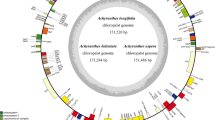Abstract
The present study compared the genetic characteristics of three previously unclassified acholeplasmas of plant origin with those of the eight established species ofAcholeplasma. A radiolabeled DNA probe was derived from the lemon (L1) strain acholeplasma by using the nick translation method and hybridized to the excess unlabeled DNA isolated from the eight established species ofAcholeplasma and three new isolates from plants. Nucleic acid hydridization and serological tests confirmed that the L1 acholeplasma was distinct from all eight established species ofAcholeplasma but closely related to strains isolated from the flowers of grapefruit trees (GF1) and powder puff plants (PP2). The results suggest that these new acholeplasmas isolated exclusively from plants may represent a new species ofAcholeplasma.
Similar content being viewed by others
Literature Cited
Aulakh, G. S., Gallo, R. C. 1977. Rauscher-leukemia-virus-related sequences in human DNA: Presence in some tissues of some patients with hematopoietic neoplasias and absence in DNA from other tissues. Proceedings of the National Academy of Sciences of the United States of America74:353–357.
Aulakh, G. S., Tully, J. G., Barile, M. F. 1979. Differentiation among some acholeplasmas by nucleic acid homology. Current Microbiology2:91–94.
Barile, M. F. 1979. Mycoplasma-tissue cell interactions, pp. 425–474. In: Tully, J. G., Whitcomb, R. F. (eds.), The mycoplasmas, vol. 2. Human and animal mycoplasmas. New York: Academic Press.
Britten, R. J., Povich, M., Smith, J. 1968. A new method for DNA purification, pp. 400–403. Annual Report of the Carnegie Institution. Washington, D. C.: Carnegie Institution.
Daniels, M. J., Meddins, B. M. 1972. Studies of plant mycoplasmas, pp. 101–102. In: 63rd Annual Report, John Innes Institute, Norwich, England.
Del Giudice, R. A., Robillard, N. F., Carski, T. R. 1967. Immunofluorescence identification ofMycoplasma on agar by use of incident illumination. Journal of Bacteriology93:1205–1209.
Eden-Green, S. J. 1977. Attempts to extract and culture mycoplasmas from coconut palms, p. 29. In: Proceedings of the Third Meeting of the International Council on Lethal Yellowing. University of Florida Publication FL-78-2.
Eden-Green, S. J. 1978. Isolation of acholeplasmas from coconuts affected by lethal yellowing disease in Jamaica. Zentralblatt für Bakteriologie, Parasitenkunde, Infektionskrankheiten und Hygiene, Abt. 1 Orig., Reihe A241:226.
Eden-Green, S. J., Tully, J. G. 1979. Isolation ofAcholeplasma sp. from coconut palms affected by lethal yellowing disease in Jamaica. Current Microbiology2:311–316.
Kelly, R. B., Cozzarelli, N. R., Deutscher, M. P., Lehman, I. R., Kornberg, A. 1970. Enzymatic synthesis of deoxyribonucleic acids. Journal of Biological Chemistry245:39–45.
Kleinhempel, M., Muller, H. M., Spaar, D. 1972. Isolierung und Kultivierung von Mycoplasmatales aus Weissklee mit Blütenvergrünungssymptomen. Archiv für Pflanzenschutz8:361–370.
Laidlaw, P. P., Elford, W. J. 1936. A new group of filterable organisms. Proceedings of the Royal Society of London, Series B120:292–303.
Laird, C. D., McConaughy, B. L., McCarthy, B. J. 1969. Rate of fixation of nucleotide substitutions in evolution. Nature224:149–154.
McCoy, R. E., Basham, M. G., Tully, J. G., Rose, D. 1980. Isolation of a new acholeplasma from flowers in Florida, p. 88. In: Abstracts of the Third Conference of the International Organization for Mycoplasmology.
Maniatis, T., Jeffrey, A., Kleid, D. G. 1975. Nucleotide sequence of the rightward operator of phage λ. Proceedings of the National Academy of Sciences of the United States of America72:1184–1188.
Orning, A. P., Ross, R. F., Barile, M. F. 1978. Isolation ofMycoplasma arginini from swine and from a swine waste disposal system. American Journal of Veterinary Research39:1169–1174.
Rose, D. L., Tully, J. G., Del Giudice, R. A. 1980.Acholeplasma morum, a new non-sterol-requiring species. International Journal of Systematic Bacteriology30:647–654.
Seiffert, G. 1937. Über das Vorkommen filtrabler Mikroorganismen in der Natur und ihre Züchtbarkeit. Zentralblatt für Bakteriologie, Parasitenkunde, Infektionskrankheiten und Hygiene, Abt. 1 Orig.140:337–342.
Somerson, N. L., Kocka, J. P., Del Giudice, R. A. 1980. Isolation of acholeplasmas from foods, p. 143. In: Abstracts of the Third Conference of the International Organization for Mycoplasmology.
International Committee on Systematic Bacteriology, Subcommittee on the Taxonomy of Mycoplasmatales. 1972. Proposal for minimal standards for descriptions of new species of the orderMycoplasmatales. International Journal of Systematic Bacteriology22:184–188.
Tully, J. G. 1979. Special features of the acholeplasmas, pp. 431–449. In: Barile, M. F., Razin, S. (eds.), The mycoplasmas, vol. 1. Cell biology. New York: Academic Press.
Tully, J. G., Barile, M. F., Edward, D. G. ff., Theodore, T. S., Ernø, H. 1974. Characterization of some caprine mycoplasmas, with proposals for new species,Mycoplasma capricolum andMycoplasma putrefaciens. Journal of General Microbiology85:102–120.
Author information
Authors and Affiliations
Rights and permissions
About this article
Cite this article
Stephens, E.B., Aulakh, G.S., McCoy, R.E. et al. Lack of genetic relatedness among animal and plant acholeplasmas by nucleic acid hybridization. Current Microbiology 5, 367–370 (1981). https://doi.org/10.1007/BF01566751
Issue Date:
DOI: https://doi.org/10.1007/BF01566751




